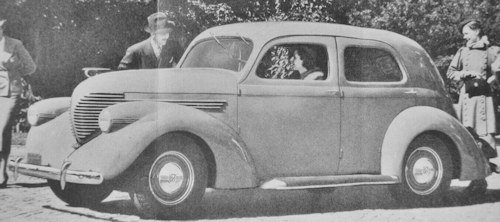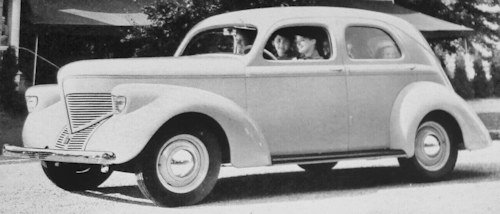Willy's 37/38/48 / Speedway / Americar
 |
|
|
Manufacturer: |
Willys-Overland |
|
Production period: |
1937 to 1942 |
|
Class: |
Motor car |
|
Body versions: |
Saloon, station wagon, coupe, pickup |
|
Engines: |
Gasoline engines :2.4 liters (35-46 kW) |
|
Overall length: |
175 in |
|
weight |
Saloon 2,250 lbs. |
The Willy's 37/38/48 / Speedway / Americar cars from Willys-Overland in Toledo (Ohio) first brought out in 1937 an updated pre-war car based on the 77. Basically, the vehicle was an evolution of the previous Whippet. In the years until the entry of the United States in the Second World War, the model series under the name Willys 37, Willys 38, Willys 48, Willys Speedway and Willys Americar was further developed. When civilian car production in the USA had to be discontinued in 1942, this vehicle also disappeared from the market. The car had a front longitudinally mounted four-cylinder in-line engine with 2388 cc and 48 bhp (35 kW) power. The wheelbase was just 2540mm and the car was offered for under $ 500, making it the cheapest American car of its time. Also, the operation was quite cheap, since the car only 9.4 ltr. Gasoline consumed to 100 km.

Model year 1937: For the model year 1937, the car was stylistically revised. A forward-looking alligator bonnet with horizontal grille bars in body colour and the headlights recessed in the bulky front fenders gave the model a more modern look. It was renamed Willys 37, but the technique remained the same. Also from the coupe, there was now a luxury version. For the model year 1938 The Willys 38 now has a rocket-shaped radiator emblem and there were new models in standard and luxury version. The Double drop, X-member type chassis frame with All-steel body, with solid steel top, sound and heat insulated, non-glare windshield and safety glass all round with remote door controls.
With leather upholstery or with cloth upholstery. in Blue or colour grey large glove box on either side of instrument panel; horn control at centre of steering wheel, starter button, throttle and choke controls, ignition lock and mechanical fuel gauge in instrument panel. The spare wheel carried in rear luggage compartment. The petrol tank at rear, with 6.6 gallons capacity.
Model year 1939: The unchanged in itself car was now Willys 48 and in addition to the "Deluxe" models, there were also "Speedway" versions (only 2-door). For a short time, the vehicles were also sold under the traditional name Overland.For the Model years 1940 The following year was another stylistic revision: The alligator bonnet was now flatter and no longer had a grille; this was now below the hood and had horizontal bars in body colour. The model was now called Willy's Speedway and its wheelbase was now 2,591 mm. In addition to the 2-door coupe and the 4-door sedan in basic and deluxe equipment, there was for the first time a station wagon in Deluxe design.
Model year 1941: The Willys Speedway was renamed Willys Americar this year; Speedway was just a name for the structure. Add to that the more expensive "Plainsman" versions. Stylistically, the cars remained unchanged, but got stronger engines with 63 bhp (46 kW) and the wheelbase grew to 2642 mm.Model year 1942: In the shortened model year 1942 (until February 1942), the Americar models were continued almost unchanged; only the grille was now chrome.

Technical
-
Willys 37/38/48 Technical details and specifications (1937-1942)
DIMENSIONS AND WEIGHT:
Track 56 in.
overall length 175 in
turning radius 17 ft
weight 2,250 lbs.ENGINE:
16-H.P. 4-Cylinder
EL-head type
bore 3 1/8 in.stroke 4 3/8 in.
134.2 cin. capacity
Treasury rating 15.63 h.p.
48 b.h.p. at 3,200 r.p.m
compression ratio 5.7:1
full-pressure lubrication to crankshaft, con-rods, camshaft and timing chain
Oil Reserve 3.3 quarts
"Float-O" floating type oil intake
centrifugal pump water circulation with cellular type radiator
radiator Capacity 9 1/2 quartTRANSMISSION DRIVE LINE:
silent synchromesh gears
single-plate dry disc clutch
reverse Elliott type front axel
Worm and sector type steering gear with safety-type steering wheel
Timken roller thrust bearings and bronze bushings on steering knuckles ;
semi-floating, unit, centre-type rear axle
differential and pinion shaft on Timken taper roller bearings
spiral-bevel ring gear and pinion of nickel alloy steel
silent U-spring shackles
oversize, cylinder type, double-action shock absorbers
BRAKES:
hand brake acting on all four wheels
Bendix duo-servo, internal expanding, two-shoe type foot-brake
having total braking area of 134 sq. in. disc type wheels, 16 X 5.50 tyres
ELECTRICAL EQUIPMENT:
Autolite starter motor and generator ;
Autolite coil and vacuum-type distributor
U.S.L. 95-ampere, 13-plate battery© Motor car History
Manuals
-
Willys Overland Previous 6 / 13 Next
